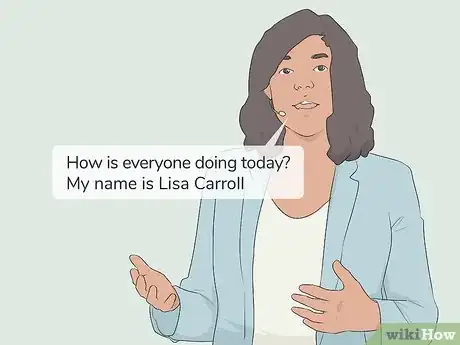This article was co-authored by Shannon O'Brien, MA, EdM. Shannon O'Brien is the Founder and Principal Advisor of Whole U. (a career and life strategy consultancy based in Boston, MA). Through advising, workshops and e-learning Whole U. empowers people to pursue their life's work and live a balanced, purposeful life. Shannon has been ranked as the #1 Career Coach and #1 Life Coach in Boston, MA by Yelp reviewers. She has been featured on Boston.com, Boldfacers, and the UR Business Network. She received a Master's of Technology, Innovation, & Education from Harvard University.
wikiHow marks an article as reader-approved once it receives enough positive feedback. This article received 44 testimonials and 84% of readers who voted found it helpful, earning it our reader-approved status.
This article has been viewed 5,132,486 times.
If you’re confused or nervous about introducing yourself to others, you’re not alone! Whether it's introducing yourself in class, to a group of new colleagues at work, or to a stranger at a party, introductions can feel uncomfortable or straight up stressful for a lot of people. The good news is that there are simple tricks you can use to make introducing yourself easier and help you make a good first impression. With practice, introducing yourself to others will become second nature and you won’t even have to think about it.
Things You Should Know
- Introduce yourself casually to new friends with a handshake and a smile. Then, offer your name and ask for theirs.
- If you're giving a speech, offer your name and relevant credentials. For example, if you're giving an academic speech, mention your research.
- At professional events, give your name and a quick description of your work. Make sure to follow up with thoughtful questions, too!
Steps
Introduction Help
Introducing Yourself in Any Social Situation
-
1Make eye contact. Eye contact shows that you're engaged in the interaction. Eye contact is one way to connect with another human and show that the other person has your attention. When you make eye contact, it shows that you are open and engaged.
- If you're not comfortable looking straight into someone's eyes, stare at the point between the eyebrows; she won't notice the difference.
- If you’re in a group setting, make periodic eye contact with those around you.
-
2Smile. It is important to keep a genuine, bright smile when you meet a new person. Be genuinely happy to meet someone new and to share a positive experience and it will help create a genuine smile. Including the upper part of your face in your smile creates a more genuine and less fabricated smile.Advertisement
-
3Use appropriate body language. Your body language should communicate that you are confident and at ease. Stand with your head high and your back straight, being careful not to slouch. Mirror the body language of people around you. Also mirror the pace of speech and tone of speech of those near you to build rapport.[1]
Introducing Yourself to an Individual
-
1Exchange names. If the introduction is formal, say "Hello, I'm [first name][last name]." If it's informal, say "Hi, I'm [first name]. Immediately after you've stated your name, ask for the other person's name by saying "What’s your name?" in a pleasant tone. When you learn the other person's name, repeat it by saying "It's a pleasure to meet you, Pedro" or "Nice to meet you, Caroline."
- Repeating the person’s name will help you remember it, and give the introduction a more personal touch.
-
2Offer a handshake or other culturally appropriate greeting. Most cultures have a form of physical contact to accompany a greeting. In the United States, it is often a handshake. Be sure to keep the handshake brief and not too loose (floppy) or firm (bone-breaking).
- Be aware of cultural differences. For instance, it is considered rude to firmly shake hands in China.
- It is often appropriate to greet with a hug, especially if you’re meeting a friend of a friend or an in-law. Hugs show more openness than a handshake. Women more often than men may prefer a hug to a handshake.
- In many cultures, it is culturally appropriate to greet with a kiss. In South America, for instance, all women are greeted with one kiss, and in France, women are greeted with one kiss on each cheek. If you are unsure of the appropriate greeting, follow the other person’s lead or watch how other people greet around you.
-
3Ask questions. It’s important to show interest in the other person. Ask where she is from, what she does for a living, or ask about any common bonds you may have. Ask about what she loves to do and the passions she has in life. Show that you are engaged and interested in what she has to say.
- You may tell a little bit of your background in order to engage conversation and share about yourself. Telling someone where you work or that you love rock climbing is appropriate and may lead to more conversation topics.
- Don’t take the opportunity to talk only about yourself. You will come across as selfish or uninteresting .
-
4Close the conversation. After you've met someone for the first time, you should end the conversation by restating that you enjoyed meeting. If the interaction was formal, say something like "Mrs. Castro, I'm delighted to have met you. I hope we can talk again soon." If your conversation was informal, you can say "It was great meeting you, Harold. Hope to see you around."
Introducing Yourself Before Giving a Speech
-
1Greet the audience and state your name. If you're giving a speech, it's important to state your first and last name. As you say hello and give your name, remember to speak clearly and confidently.
- Say, "Good morning, I’m Chelle Arnold" or "How is everyone doing today? My name is Lisa Carroll".
-
2Share some relevant information about yourself. After you provide your name, share why you and the speech are relevant, making sure you provide your credibility. The sort of information you share will depend on the audience and the subject you'll be talking about. If you're giving a speech about the importance of eating organic foods, tell people that you're a scientist, chef, or environmental professional. If you’re giving a speech about child development, be sure to include that you are a child psychologist.
- Provide any other relevant information. For instance, you can provide a brief background of your credible experience. “My name is Erica Lafaurie and I am a professor of environmental science at Berkeley. After I conducted my research in the Amazon rainforest, I realized how important it is to share ways to protect this land.”
-
3Communicate effectively. From the very start, make sure your voice is loud enough for everyone to hear you. Avoid mumbling by enunciating your consonants crisply. You can even ask the audience if you are speaking loudly enough for all to hear. People will not be able to understand you or respect what you are sharing if they cannot hear you.
-
4Move your body. Stand with good posture, and move freely while you speak. Stand up tall, move your shoulders back instead of slouching, and keep your hands free, using them to gesture when necessary. If you don't have to stand behind a podium, then walk around to show the crowd how comfortable you are and to make yourself look less stiff.
Introducing Yourself at a Professional Event
-
1Say your full name. Make sure you provide your full name so that the person can remember your name. You can say, "Hi, my name is Mark Salazar," or "Hello, I'm Angela Grace," and they'll be more likely to remember you.
-
2Give a one-sentence description of what you do. If you're at a networking event, then it's likely that you'll be talking about what you do to a variety of people. So, what do you say when a new connection asks, "What is it that you do?" Do you launch into a ten-minute story about your career path? Do you reel off a list of your accomplishments in your field? Absolutely not. Unless you're having a more lengthy conversation, you should be prepared to give a one-sentence description of what you do that gives the following information:[2]
- Who are you, professionally? Are you a teacher, a project manager, or a health care professional?
- Who do you work with? Do you work with children, cross-cultural project teams, or micro-finance organizations?
- What do you do? Do you help second-grade children develop their writing skills, do you help cross-cultural teams meet complete their goals while keeping their budgets, or do you help microfinance organizations expand their market base in developing countries?
- Now, put your sentence together. State who you are, who you work with, and what you do.
EXPERT TIPShannon O'Brien is the Founder and Principal Advisor of Whole U. (a career and life strategy consultancy based in Boston, MA). Through advising, workshops and e-learning Whole U. empowers people to pursue their life's work and live a balanced, purposeful life. Shannon has been ranked as the #1 Career Coach and #1 Life Coach in Boston, MA by Yelp reviewers. She has been featured on Boston.com, Boldfacers, and the UR Business Network. She received a Master's of Technology, Innovation, & Education from Harvard University.Life & Career Coach
 Shannon O'Brien, MA, EdM
Shannon O'Brien, MA, EdM
Life & Career CoachFor a job interview, choose highlights from your resume to introduce yourself. Many interviewers start the process by asking you to tell them about yourself. Instead of talking about non-relevant information, cherry-pick highlights from your resume that fall in line with the job you're interviewing for. You can also add personal details later in the introduction.
-
3Respect people’s space. If you have items, don’t place them on recruiter’s or presenter’s tables. Respect their space and don’t overwhelm them. You can also disrupt their materials, such as knocking over a poster or messing up pamphlets. Wait to be asked to exchange business cards, resumes, etc.[3]
-
4Follow up with a question. If the person has asked you what you do first, don't just walk away and praise yourself for a job well done. Instead, ask the person what he or she does in return. This is not only polite, but shows that you have a real interest in this person's career path and want to build a meaningful connection.
-
5Say goodbye like a professional. Don't just wave and say, "Nice meeting you" and walk away from the person. Anyone you meet at a networking event can have the potential to help you in the future, so make sure that you make eye contact, repeat the person's name, and exchange business cards or any other pieces of relevant information before you walk away.
Community Q&A
-
QuestionI have to introduce myself in front of the class. How should I do that?
 Community AnswerSay your name. Say one thing you like to do. Smile. Look confident. Don't go on about yourself. If you're a kid, just say your name, what you like, and that you're excited to attend the class. If you're a grown up attending the class, do the same. If you're teaching, say your name, what you like, and your expectations.
Community AnswerSay your name. Say one thing you like to do. Smile. Look confident. Don't go on about yourself. If you're a kid, just say your name, what you like, and that you're excited to attend the class. If you're a grown up attending the class, do the same. If you're teaching, say your name, what you like, and your expectations. -
QuestionHow do I introduce myself without people thinking I'm weird or freaky?
 Community AnswerJust be yourself. Don't think about what other people think about you. Simply say something like, "Hi, I'm [your name]." People will not think you're weird. Face your fears and you will probably make lots of friends.
Community AnswerJust be yourself. Don't think about what other people think about you. Simply say something like, "Hi, I'm [your name]." People will not think you're weird. Face your fears and you will probably make lots of friends. -
QuestionI want to befriend a group of girls, but no conversation seems right. I'm frustrated because I've been wanting to for months but I lack the confidence. How should I do this?
 BexterloveCommunity AnswerDon't worry too much about starting the perfect conversation. Sometimes just introducing yourself and asking someone about their day or week can be a great conversation starter that can help bring up some common ground. Also, it can be really helpful to plan an event, like doing something later in the day or week, which can help give purpose to the conversation.
BexterloveCommunity AnswerDon't worry too much about starting the perfect conversation. Sometimes just introducing yourself and asking someone about their day or week can be a great conversation starter that can help bring up some common ground. Also, it can be really helpful to plan an event, like doing something later in the day or week, which can help give purpose to the conversation.
References
About This Article
If you need to introduce yourself in a social situation, make eye contact with the other person. Offer a genuine, bright smile, and a culturally appropriate greeting like a handshake or a hug. Tell the person your name and ask for theirs, then repeat their name to help you remember it. Ask questions to learn more about the other person, like where they are from or what they do for a living, to make your meeting more personal. You can also tell them a little bit about yourself if you like. End the conversation by telling the person it was nice to meet them. To learn more from our Social Worker co-author, such as how to introduce yourself during a speech or professional event, keep reading the article!









































































